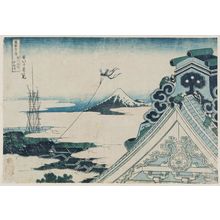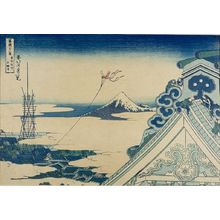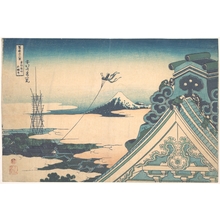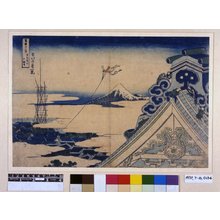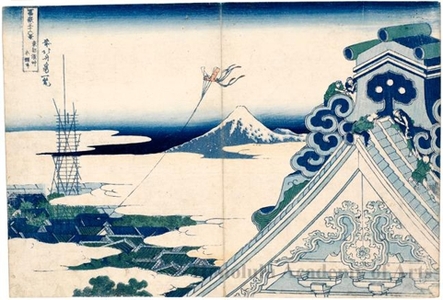Japanischer Druck "Honganji Temple at Asakusa in Edo" von Katsushika Hokusai
Künstler:Katsushika Hokusai
Titel:Honganji Temple at Asakusa in Edo
Datum:c. 1830 - 1834
Details:Mehr Informationen...
Quelle:Honolulu Museum of Art
Durchsuchen aller 5.476 Drucke...
Beschreibung:
Asakusa was the most populous district in Edo in Hokusai’s time. Its streets were crowded with stores where busy merchants and craftsmen lived and vigorously plied their trades. One of the district’s landmarks was the enormous Asakusa Honganji Temple, built in 1657, which belonged to a branch of Kyoto Higashi Honganji, the headquarters of Buddhism’s Eastern School of the Pure Land (Jödo) sect. Begun in the Late Heian period (late eleventh century), the Pure Land sect quickly gained a large following. It had one simple, compassionate teaching – that enlightenment (salvation) could be attained not through the study of sutras or observation of complicated rituals, as required in other sects, but simply by sincerely calling Amida’s name. In the Edo period, this teaching spread, and Pure Land became the largest Buddhist sect, with large temples all over Japan. In this composition, Hokusai brought the temple building so close to the foreground that only the triangle of the roof’s pediment is visible. Looking down, one can observe the sea of roofs of smaller houses, over which decorative clouds float. Mount Fuji, above them, repeats the roof’s shape. Hokusai’s dramatic compositional scheme enlarges the temple roof to an enormous proportion, dwarfing houses and the mountain. On the temple’s steep roof, workmen are busy making repairs. Their exaggerated, precise postures are drawn from studies Hokusai made of form and movement, which culminated in the publication of his sketchbooks, the Manga. The towering structure at the left is a scaffold rising over a well excavation. A kite indicates that the season is winter, most likely New Year’s day. The windy days of winter are best for flying kites, the symbol of the new year. Pale pink in the cloud and the kite enlivens a monochromatic blue print. The key-block was printed in blue. (The Asian Art Museum of San Francisco, HOKUSAI AND HIROSHIGE – Great Japanese Prints from the James A. Michener Collection, Honolulu Academy of Arts: The Asian Art Museum of San Francisco, 1998 Page 65. Cat. 16)
Ähnliche Drucke




